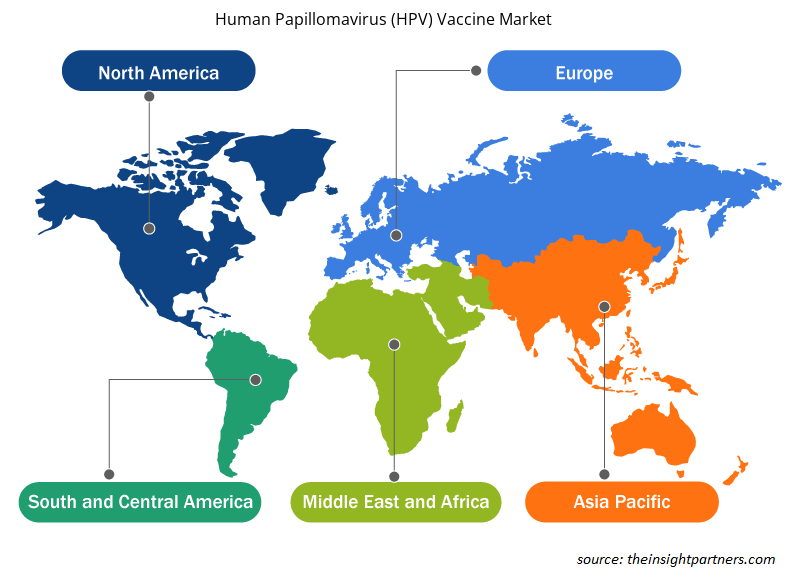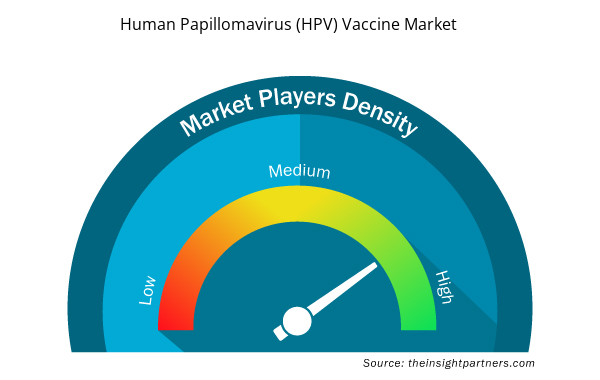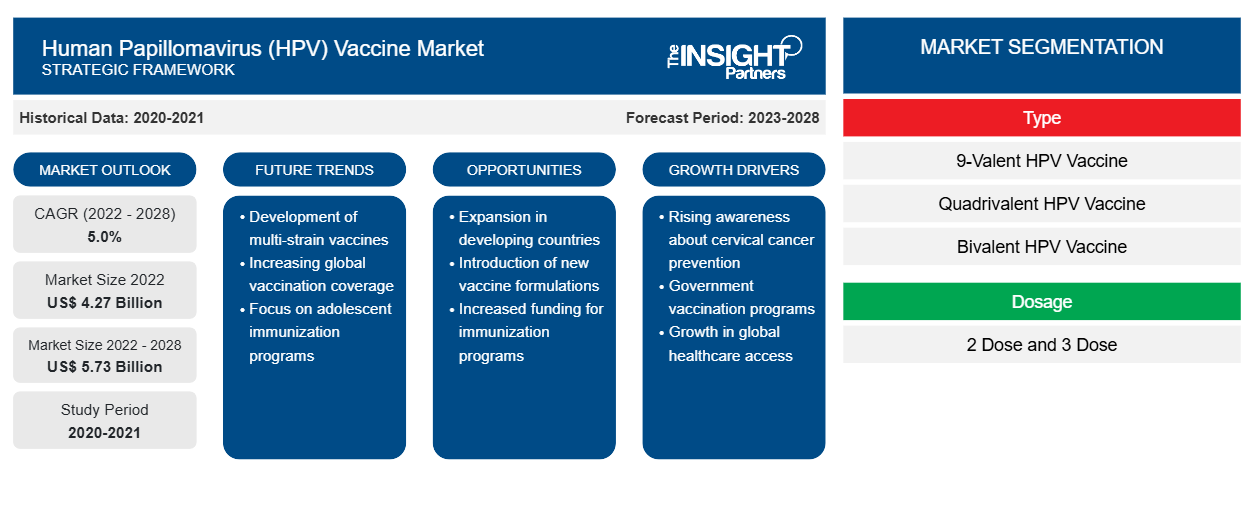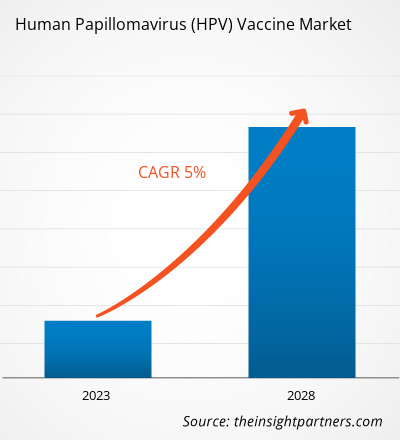Der Markt für Impfstoffe gegen humane Papillomaviren (HPV) wurde im Jahr 2022 auf 4.273,84 Millionen US-Dollar geschätzt und soll bis 2028 5.730,50 Millionen US-Dollar erreichen; es wird erwartet, dass er von 2022 bis 2028 mit einer durchschnittlichen jährlichen Wachstumsrate von 5,0 % wächst.
Humane Papillomviren (HPV) sind eine vielfältige Gruppe DNA-basierter Viren, die die Schleimhäute und Hautmembranen von Menschen und verschiedenen Tieren infizieren. Mehr als 100 verschiedene HPV-Typen wurden charakterisiert. Die zunehmende Verbreitung verschiedener durch HPV verursachter Krebsarten wird voraussichtlich den Markt für Impfstoffe gegen humane Papillomviren (HPV) im Prognosezeitraum ankurbeln. Laut den Centers for Disease Control and Prevention (CDC) ist HPV die häufigste sexuell übertragbare Infektion in den USA. Über 60 % der Peniskrebserkrankungen, 70 % der Vulva- und Vaginalkrebserkrankungen und 90 % der Anal- und Gebärmutterhalskrebserkrankungen werden durch eine HPV-Infektion verursacht. Die CDC gibt außerdem an, dass sich in den USA jedes Jahr etwa 14 Millionen Menschen neu mit dem Virus infizieren.
Passen Sie diesen Bericht Ihren Anforderungen an
Sie erhalten kostenlos individuelle Anpassungen an jedem Bericht, einschließlich Teilen dieses Berichts oder einer Analyse auf Länderebene, eines Excel-Datenpakets sowie tolle Angebote und Rabatte für Start-ups und Universitäten.
- Holen Sie sich die wichtigsten Markttrends aus diesem Bericht.Dieses KOSTENLOSE Beispiel umfasst eine Datenanalyse von Markttrends bis hin zu Schätzungen und Prognosen.
Der globale Markt für Impfstoffe gegen humane Papillomaviren (HPV) ist nach Typ, Dosierung, Alter, Vertriebskanal und Geografie segmentiert. Der Markt ist nach Regionen in Nordamerika, Europa, Asien-Pazifik, den Nahen Osten und Afrika sowie Süd- und Mittelamerika unterteilt. Der Bericht bietet Einblicke und eine eingehende Analyse des Marktes für Impfstoffe gegen humane Papillomaviren (HPV) und betont dabei verschiedene Parameter wie Markttrends, technologische Fortschritte und Marktdynamik. Er umfasst auch die Wettbewerbslandschaftsanalyse führender Marktteilnehmer auf der ganzen Welt.
Markteinblick
Zunahme der Prävalenz von HPV-assoziierten Erkrankungen
Das humane Papillomavirus (HPV) ist eine häufige sexuell übertragbare Infektionskrankheit und kann Gebärmutterhalskrebs, Oropharynxkrebs sowie Vaginal-, Vulva-, Penis- oder Anuskrebs verursachen. Es verursacht auch verschiedene Krankheiten wie Anogenitalwarzen und rezidivierende respiratorische Papillomatose . HPVs wurden auch in Lichen sclerosus , Hautlappen, seborrhoischen Keratosen , Epidermalzysten, aktinischen Keratosen und Psoriasis- Plaques nachgewiesen. Eine erhebliche Belastung durch HPV-assoziierte Krankheiten wird wahrscheinlich das Wachstum des Marktes vorantreiben.
Bei Frauen ist Gebärmutterhalskrebs die vierthäufigste Krebsart. Laut einem Bericht der Weltgesundheitsorganisation (WHO) erkrankten im Jahr 2018 weltweit schätzungsweise 570.000 Frauen an Gebärmutterhalskrebs, und etwa 311.000 Todesfälle bei Frauen waren auf Gebärmutterhalskrebs zurückzuführen. Darüber hinaus schätzte die American Society of Clinical Oncology ( ASCO ), dass allein in den USA rund 14.100 Fälle von invasivem Gebärmutterhalskrebs registriert wurden. Laut dem Bericht „Gebärmutterhalskrebsbelastung in der EU-27“ gab es im Jahr 2020 30.447 Neuerkrankungen und 13.437 Todesfälle aufgrund von Gebärmutterhalskrebs bei Frauen.
Laut den Centers for Disease Control and Prevention (CDC) gab es im Jahr 2018 in den USA rund 43 Millionen HPV-Infektionen. Die CDC schätzt außerdem, dass jährlich etwa 19.400 Frauen und 12.100 Männer an durch HPV verursachtem Krebs erkranken. Und laut der National Foundation for Infectious Diseases ( NFID ) gibt es in den USA jedes Jahr rund 14 Millionen neue Fälle von HPV-Infektionen. Darüber hinaus erkrankten laut dem Bericht „Human Papillomavirus and Related Diseases Report-Europe“ im Jahr 2020 in Europa 8.449 Frauen und 4.327 Männer an Analkrebs.
Eine derart hohe Inzidenz von HPV-assoziierten Infektionen weltweit dürfte das allgemeine Marktwachstum in den kommenden Jahren begünstigen.
Typbasierte Erkenntnisse
Der Markt für Impfstoffe gegen humane Papillomviren (HPV) ist nach Typ in 9-valente HPV-Impfstoffe, quadrivalente HPV-Impfstoffe und bivalente HPV-Impfstoffe unterteilt. Im Jahr 2022 hält das Segment der quadrivalenten HPV-Impfstoffe den größten Marktanteil. Es wird jedoch erwartet, dass der Markt für das Segment der 9-valenten HPV-Impfstoffe von 2022 bis 2028 ein rasantes Wachstum verzeichnen wird. Der quadrivalente Impfstoff gegen humane Papillomviren (HPV) schützt vor einer Infektion mit den HPV-Typen 6, 11, 16 und 18, die für 70 bis 80 % der Fälle von Gebärmutterhalskrebs und mindestens 90 % der Fälle von Genitalwarzen verantwortlich sind. Der Impfstoff verringert das Risiko von Genitalwarzen und den Vorstufen von Gebärmutterhals-, Vaginal- und Vulvakrebs , die durch das Virus verursacht werden.
Dosierungsbasierte Erkenntnisse
Basierend auf der Dosierung ist der Markt für Impfstoffe gegen humane Papillomaviren (HPV) in 2-Dosen- und 3-Dosen-Impfstoffe unterteilt. Im Jahr 2022 hat das 2-Dosen-Segment einen größeren Marktanteil.papillomavirus (HPV) vaccine market is segmented into 2 dose and 3 dose. In 2022, the 2 dose segment accounts for a larger market share.
Altersbasierte Erkenntnisse
Der globale Markt für Impfstoffe gegen humane Papillomaviren (HPV) ist nach Alter in die Altersgruppen 9 bis 14 und 15 bis 45 unterteilt. Das Segment der 9- bis 14-Jährigen hatte im Jahr 2022 einen größeren Marktanteil, und es wird erwartet, dass dasselbe Segment im Prognosezeitraum eine höhere durchschnittliche jährliche Wachstumsrate verzeichnet.papillomavirus (HPV) vaccine market, based on age, is segmented into 9 to 14 years and 15 to 45 years. The 9 to 14 years segment held a larger market share in 2022, and the same segment is anticipated to register a higher CAGR during the forecast period.
Anwendungsbasierte Erkenntnisse
In Bezug auf die Anwendung ist der globale Markt für Impfstoffe gegen humane Papillomaviren (HPV) in HPV-bedingte Krebserkrankungen und Genitalwarzen unterteilt. Das Segment HPV-bedingte Krebserkrankungen hält im Jahr 2022 einen größeren Marktanteil, und es wird erwartet, dass dasselbe Segment im Prognosezeitraum eine höhere durchschnittliche jährliche Wachstumsrate verzeichnet.papillomavirus (HPV) vaccine market is segmented into HPV-attributable cancers and genital warts. The HPV-attributable cancers segment holds a larger market share in 2022, and the same segment is anticipated to register a higher CAGR during the forecast period.
Einblicke basierend auf Vertriebskanälen
Auf der Grundlage des Vertriebskanals ist der globale Markt für Impfstoffe gegen humane Papillomaviren (HPV) in Arztpraxen, kommunale Gesundheitszentren, schulbasierte Gesundheitszentren, Gesundheitsämter, Krankenhäuser und andere unterteilt. Das Krankenhaussegment hält im Jahr 2022 den größten Marktanteil, und das Segment der schulbasierten Gesundheitszentren wird im Prognosezeitraum voraussichtlich die höchste durchschnittliche jährliche Wachstumsrate auf dem Markt verzeichnen.papillomavirus (HPV) vaccine market is segmented into doctors office, community health clinics, school-based health centers, health departments, hospitals, and others. The hospitals segment holds the largest share of the market in 2022, and the school-based health centers segment is anticipated to register the highest CAGR in the market during the forecast period.
Die COVID-19-Pandemie wird voraussichtlich längerfristige Folgen für das Geschäft mit HPV-Impfstoffen haben. Viele Kliniken der Primärversorgung in den USA arbeiten weiterhin mit reduzierter Kapazität, um soziale Distanzierungsmaßnahmen einzuhalten und strenge Reinigungsprotokolle einzuführen. Eine Verringerung der persönlichen Sprechstundenbesuche begrenzt die Möglichkeiten der Impfstoffanbieter, Impfstoffe zu besprechen und bereitzustellen. Transporthindernisse schaden wahrscheinlich der HPV-Impfung; Pharma- und Biotech-Unternehmen haben traditionell Schwierigkeiten, Impfstoffe unter den Massen zu vermarkten, da sie auf Widerstand seitens der Eltern stoßen und die Schulzugangsvoraussetzungen, die andere Impfstoffe für Jugendliche unterstützen, nicht weithin bekannt sind. Die verfügbaren Beweise deuten darauf hin, dass die COVID-19-Pandemie die Bereitstellung von HPV-Impfstoffen in den Jahren 2020 und 2021 dramatisch gestört hat. Erste Berichte der CDC deuten darauf hin, dass die Bestellungen und Abrechnungen im März 2020 um über 70 % zurückgegangen sind. Darüber hinaus setzte sich im Juni 2020 ein Rückgang der HPV-Impfstoffbestellungen um 25–50 % fort, im Gegensatz zu anderen Bestellungen für Impfstoffe für die frühe Kindheit, die wieder fast auf das Niveau vor der Pandemie anstiegen. Obwohl der Markt für HPV-Impfstoffe derzeit wieder auflebt, deuten die verfügbaren Daten darauf hin, dass die HPV-Impfraten kurzfristig erheblich zurückgehen werden, die Nachfrage nach HPV-Impfstoffen jedoch in ganz Nordamerika langfristig steigen wird.
Regionale Einblicke in den Markt für Impfstoffe gegen humane Papillomaviren (HPV)Papillomavirus (HPV) Vaccine Market Regional Insights
Die regionalen Trends und Faktoren, die den Markt für Impfstoffe gegen humane Papillomviren (HPV) im Prognosezeitraum beeinflussen, wurden von den Analysten von Insight Partners ausführlich erläutert. In diesem Abschnitt werden auch die Marktsegmente und die Geografie für Impfstoffe gegen humane Papillomviren (HPV) in Nordamerika, Europa, im asiatisch-pazifischen Raum, im Nahen Osten und Afrika sowie in Süd- und Mittelamerika erörtert.Papillomavirus (HPV) Vaccine Market throughout the forecast period have been thoroughly explained by the analysts at Insight Partners. This section also discusses Human Papillomavirus (HPV) Vaccine Market segments and geography across North America, Europe, Asia Pacific, Middle East and Africa, and South and Central America.

- Erhalten Sie regionale Daten zum Markt für Impfstoffe gegen humane Papillomaviren (HPV)Papillomavirus (HPV) Vaccine Market
Umfang des Marktberichts zum Impfstoff gegen humane Papillomaviren (HPV)Papillomavirus (HPV) Vaccine Market Report Scope
| Berichtsattribut | Details |
|---|---|
| Marktgröße im Jahr 2022 | 4,27 Milliarden US-Dollar |
| Marktgröße bis 2028 | 5,73 Milliarden US-Dollar |
| Globale CAGR (2022 - 2028) | 5,0 % |
| Historische Daten | 2020-2021 |
| Prognosezeitraum | 2023–2028 |
| Abgedeckte Segmente | Nach Typ
|
| Abgedeckte Regionen und Länder | Nordamerika
|
| Marktführer und wichtige Unternehmensprofile |
|
Dichte der Marktteilnehmer für Impfstoffe gegen humane Papillomaviren (HPV): Auswirkungen auf die Geschäftsdynamik
Der Markt für Impfstoffe gegen humane Papillomviren (HPV) wächst rasant. Dies wird durch die steigende Nachfrage der Endnutzer aufgrund von Faktoren wie sich entwickelnden Verbraucherpräferenzen, technologischen Fortschritten und einem größeren Bewusstsein für die Vorteile des Produkts vorangetrieben. Mit der steigenden Nachfrage erweitern Unternehmen ihr Angebot, entwickeln Innovationen, um die Bedürfnisse der Verbraucher zu erfüllen, und nutzen neue Trends, was das Marktwachstum weiter ankurbelt.Papillomavirus (HPV) Vaccine Market market is growing rapidly, driven by increasing end-user demand due to factors such as evolving consumer preferences, technological advancements, and greater awareness of the product's benefits. As demand rises, businesses are expanding their offerings, innovating to meet consumer needs, and capitalizing on emerging trends, which further fuels market growth.
Die Marktteilnehmerdichte bezieht sich auf die Verteilung der Firmen oder Unternehmen, die in einem bestimmten Markt oder einer bestimmten Branche tätig sind. Sie gibt an, wie viele Wettbewerber (Marktteilnehmer) in einem bestimmten Marktraum im Verhältnis zu seiner Größe oder seinem gesamten Marktwert präsent sind.
Die wichtigsten auf dem Markt für Impfstoffe gegen humane Papillomaviren (HPV) tätigen Unternehmen sind:Papillomavirus (HPV) Vaccine Market are:
- Merck & Co. In.
- GSK
- Serum-Institut von Indien
- Walvax Biotechnologies Biotechnologies
- Innova
Haftungsausschluss : Die oben aufgeführten Unternehmen sind nicht in einer bestimmten Reihenfolge aufgeführt.

- Überblick über die wichtigsten Akteure auf dem Markt für Impfstoffe gegen humane Papillomaviren (HPV)Papillomavirus (HPV) Vaccine Market top key players overview
Unternehmen verfolgen häufig Produktneueinführungs- und Expansionsstrategien, um ihre Präsenz weltweit zu vergrößern, die steigende Nachfrage zu befriedigen und ihr Produktportfolio zu erweitern. Die Akteure auf dem globalen Markt für Impfstoffe gegen humane Papillomviren (HPV) setzen die Strategie der Produktinnovation um, um der sich weltweit ändernden Kundennachfrage gerecht zu werden, was es ihnen auch ermöglicht, ihren Markennamen weltweit aufrechtzuerhalten.papillomavirus (HPV) vaccine market implement the strategy of product innovation for changing customer demand worldwide, which also permits them to maintain their brand name globally.
- Im Mai 2022 genehmigte die chinesische National Medical Products Administration (NMPA) den Zwei-Dosen-Impfstoff Cervarix von GlaxoSmithKline (GSK) für Mädchen im Alter von 9 bis 14 Jahren zur Vorbeugung von Gebärmutterhalskrebs. Cervarix ist ein rekombinanter, nicht infektiöser, AS04-adjuvantierter bivalenter HPV-Impfstoff (Typ 16, 18).NMPA) approved GlaxoSmithKline’s (GSK) two-dose vaccine schedule, Cervarix, in girls from 9 to 14 years to prevent cervical cancer. Cervarix is a recombinant, noninfectious, AS04-adjuvanted HPV bivalent (types 16, 18) vaccine.
- Im Mai 2022 gab das Serum Institute of India die Entwicklung eines tetravalenten HPV-Impfstoffs bekannt, der L1-VLPs der Serotypen 6, 11, 16 und 18 enthält und voraussichtlich einen Schutz von etwa 90 % gegen Papillomaviren bieten wird. Der Impfstoff befindet sich derzeit in der Entwicklung.tetravalent HPV vaccine including L1 VLPs of serotypes 6,11,16,18, which is expected to give a coverage of ~90% against papillomavirus. The vaccine is currently under development.
- Im Mai 2020 arbeitete Shanghai Bovax Biotechnology mit Chongoing Bovax Biopharmaceutical zusammen, um die Immunogenität und Sicherheit von 4-valenten und 9-valenten rekombinanten HPV-Impfstoffen zu bewerten.
Geografisch ist der Markt für Impfstoffe gegen humane Papillomaviren (HPV) segmentiert in Nordamerika (USA, Kanada und Mexiko), Europa (Großbritannien, Deutschland, Frankreich, Italien, Spanien, Russland, Weißrussland und restliches Europa), Asien-Pazifik (China, Japan, Indien, Australien, Südostasien, Neuseeland, Südkorea und restlicher Asien-Pazifik-Raum), Naher Osten und Afrika (VAE, Saudi-Arabien, Südafrika, Iran, Türkei, Kuwait, Bahrain, Ägypten und restlicher Naher Osten und Afrika) sowie Süd- und Mittelamerika (Brasilien, Argentinien, Chile, Guatemala, Peru, Kolumbien und restliches Süd- und Mittelamerika). GSK; Innovax; Walvax; Serum Institute of India Pvt., Ltd.; Vaccitech; Innovio Pharmaceuticals; Merck & Co., Inc.; 2A Pharm; ChengDu Institute of Biological Products Co., Ltd.; Sanofi; R-Pharm; Shanghai Bowei; und BioLeaders gehören zu den führenden Unternehmen auf dem Markt.
- Historische Analyse (2 Jahre), Basisjahr, Prognose (7 Jahre) mit CAGR
- PEST- und SWOT-Analyse
- Marktgröße Wert/Volumen – Global, Regional, Land
- Branche und Wettbewerbsumfeld
- Excel-Datensatz



Report Coverage
Revenue forecast, Company Analysis, Industry landscape, Growth factors, and Trends

Segment Covered
This text is related
to segments covered.

Regional Scope
North America, Europe, Asia Pacific, Middle East & Africa, South & Central America

Country Scope
This text is related
to country scope.
Häufig gestellte Fragen
The human papillomavirus vaccine market majorly consists of the players such Merck & Co. In., GSK, Serum Institute of India, Walvax Biotechnologies, Innovax, Vaccitech, Innovio Pharmaceuticals, Chengdu Institute of Biological Products Co., Ltd., Sanofi, R-Pharm, Shanghai Bowei, and Bioleaders amongst others.
The human papillomavirus vaccine market, by type, is bifurcated 9-valent HPV vaccine, quadrivalent HPV vaccine, and bivalent HPV vaccine. In 2022, the quadrivalent HPV vaccine segment held the largest share of the market, by type. However, the 9-valent HPV vaccine segment is expected to witness the fastest growth during 2022 to 2028.
Driving factor such as increase in prevalence of HPV associated diseases and initiatives taken by global health organizations are likely to have a positive impact on the growth of the global human papillomavirus (HPV) vaccines market. Whereas factors, such as growing number of HPV awareness programs, are likely to create a growth opportunity on the HPV vaccines market in the near future.
Human papillomaviruses is a diverse group of DNA-based viruses that infect the mucous and skin membranes of humans and various animals. More than 100 different types of human papillomavirus have been characterized. Increasing prevalence of various cancers caused by human papillomavirus is expected to drive the market during the forecast period. According to the Centers for Disease Control and Prevention (CDC), human papillomavirus is the most common sexually transmitted infection in the U.S. Over 60% of penile cancers, 70% of vulvar and vaginal cancers, and 90% of anal and cervical cancers are caused due to human papillomavirus infection. CDC also states that about 14 million people are newly infected by human papillomavirus every year in the U.S.
Trends and growth analysis reports related to Life Sciences : READ MORE..
The List Of Companies - HPV Vaccines Market
- Merck & Co. In.
- GSK
- Serum Institute of India
- Walvax Biotechnologies
- Innova
- Vaccitech
- Innovio Pharmaceuticals
- Chengdu Institute of Biological Products Co., Ltd.
- Sanofi
- R-Pharm
- Shanghai Bowei
- Bioleaders
The Insight Partners performs research in 4 major stages: Data Collection & Secondary Research, Primary Research, Data Analysis and Data Triangulation & Final Review.
- Data Collection and Secondary Research:
As a market research and consulting firm operating from a decade, we have published and advised several client across the globe. First step for any study will start with an assessment of currently available data and insights from existing reports. Further, historical and current market information is collected from Investor Presentations, Annual Reports, SEC Filings, etc., and other information related to company’s performance and market positioning are gathered from Paid Databases (Factiva, Hoovers, and Reuters) and various other publications available in public domain.
Several associations trade associates, technical forums, institutes, societies and organization are accessed to gain technical as well as market related insights through their publications such as research papers, blogs and press releases related to the studies are referred to get cues about the market. Further, white papers, journals, magazines, and other news articles published in last 3 years are scrutinized and analyzed to understand the current market trends.
- Primary Research:
The primarily interview analysis comprise of data obtained from industry participants interview and answers to survey questions gathered by in-house primary team.
For primary research, interviews are conducted with industry experts/CEOs/Marketing Managers/VPs/Subject Matter Experts from both demand and supply side to get a 360-degree view of the market. The primary team conducts several interviews based on the complexity of the markets to understand the various market trends and dynamics which makes research more credible and precise.
A typical research interview fulfils the following functions:
- Provides first-hand information on the market size, market trends, growth trends, competitive landscape, and outlook
- Validates and strengthens in-house secondary research findings
- Develops the analysis team’s expertise and market understanding
Primary research involves email interactions and telephone interviews for each market, category, segment, and sub-segment across geographies. The participants who typically take part in such a process include, but are not limited to:
- Industry participants: VPs, business development managers, market intelligence managers and national sales managers
- Outside experts: Valuation experts, research analysts and key opinion leaders specializing in the electronics and semiconductor industry.
Below is the breakup of our primary respondents by company, designation, and region:

Once we receive the confirmation from primary research sources or primary respondents, we finalize the base year market estimation and forecast the data as per the macroeconomic and microeconomic factors assessed during data collection.
- Data Analysis:
Once data is validated through both secondary as well as primary respondents, we finalize the market estimations by hypothesis formulation and factor analysis at regional and country level.
- Macro-Economic Factor Analysis:
We analyse macroeconomic indicators such the gross domestic product (GDP), increase in the demand for goods and services across industries, technological advancement, regional economic growth, governmental policies, the influence of COVID-19, PEST analysis, and other aspects. This analysis aids in setting benchmarks for various nations/regions and approximating market splits. Additionally, the general trend of the aforementioned components aid in determining the market's development possibilities.
- Country Level Data:
Various factors that are especially aligned to the country are taken into account to determine the market size for a certain area and country, including the presence of vendors, such as headquarters and offices, the country's GDP, demand patterns, and industry growth. To comprehend the market dynamics for the nation, a number of growth variables, inhibitors, application areas, and current market trends are researched. The aforementioned elements aid in determining the country's overall market's growth potential.
- Company Profile:
The “Table of Contents” is formulated by listing and analyzing more than 25 - 30 companies operating in the market ecosystem across geographies. However, we profile only 10 companies as a standard practice in our syndicate reports. These 10 companies comprise leading, emerging, and regional players. Nonetheless, our analysis is not restricted to the 10 listed companies, we also analyze other companies present in the market to develop a holistic view and understand the prevailing trends. The “Company Profiles” section in the report covers key facts, business description, products & services, financial information, SWOT analysis, and key developments. The financial information presented is extracted from the annual reports and official documents of the publicly listed companies. Upon collecting the information for the sections of respective companies, we verify them via various primary sources and then compile the data in respective company profiles. The company level information helps us in deriving the base number as well as in forecasting the market size.
- Developing Base Number:
Aggregation of sales statistics (2020-2022) and macro-economic factor, and other secondary and primary research insights are utilized to arrive at base number and related market shares for 2022. The data gaps are identified in this step and relevant market data is analyzed, collected from paid primary interviews or databases. On finalizing the base year market size, forecasts are developed on the basis of macro-economic, industry and market growth factors and company level analysis.
- Data Triangulation and Final Review:
The market findings and base year market size calculations are validated from supply as well as demand side. Demand side validations are based on macro-economic factor analysis and benchmarks for respective regions and countries. In case of supply side validations, revenues of major companies are estimated (in case not available) based on industry benchmark, approximate number of employees, product portfolio, and primary interviews revenues are gathered. Further revenue from target product/service segment is assessed to avoid overshooting of market statistics. In case of heavy deviations between supply and demand side values, all thes steps are repeated to achieve synchronization.
We follow an iterative model, wherein we share our research findings with Subject Matter Experts (SME’s) and Key Opinion Leaders (KOLs) until consensus view of the market is not formulated – this model negates any drastic deviation in the opinions of experts. Only validated and universally acceptable research findings are quoted in our reports.
We have important check points that we use to validate our research findings – which we call – data triangulation, where we validate the information, we generate from secondary sources with primary interviews and then we re-validate with our internal data bases and Subject matter experts. This comprehensive model enables us to deliver high quality, reliable data in shortest possible time.


 Holen Sie sich ein kostenloses Muster für diesen Bericht
Holen Sie sich ein kostenloses Muster für diesen Bericht